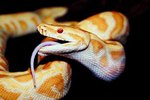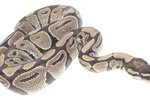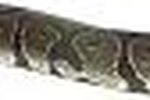
When it comes to hunting for food, snakes run the gamut as far as technique goes. Some snakes seize their prey by injecting them with venomous bites. Other types, like pythons, opt for a different, decidedly more "squeezy" approach, which is known as constriction. Pythons are nonvenomous reptiles.
Search for Sustenance
When pythons are on the lookout for their next meals, they rely on a combination of smell and vision. They never chase after their targets and instead simply opt to catch them off-guard. They lurk in a clandestine manner and when ready, swoop in on the unsuspecting prey. Pythons possess a convenient adaptation that enables them to detect the body heat of nearby prey, too -- pits that are situated around their jaws. These pits are handy for helping pythons more easily track down warm-blooded creatures amid less than ideal lighting conditions.
Constriction for Catching Prey
Once a python is near his desired prey, he rapidly uses his teeth to seize the animal. He then proceeds to coil his body around the prey, preventing breathing from continuing, and therefore triggering suffocation. This constriction promptly kills the animal. When the animal breathes out, the python's grip gets more and more severe. The squeezing action doesn't shatter the bones -- it just stops the breathing. Once the python no longer notices the prey animal's heartbeat, he finally removes his intense grasp -- time to eat. When he eats his prey, he swallows the lifeless body starting at the head. After he's through eating, he retreats to a warm and cozy place for the digestion process.
Diverse Prey Animals
Pythons feed on a vast assortment of animals. Although they generally favor mammals and birds, they're more than willing to eat fish, amphibians and reptiles, too. Larger pythons generally go for larger prey, from crocodiles to deer. Smaller specimens focus on tinier creatures such as ducks and mice. Other prey animals that make regular appearances in python diets are antelope, pigeons, jackals, gazelles, monkeys, pigs, opossums, hares, wallabies and impalas. Pythons have even been known to eat leopards, albeit smaller specimens.
Unhurried Attitude
Pythons possess a rather unhurried and calm attitude in their approach to catching prey animals. They often hang out in trees for days on end anticipating the perfect opportunity to move in on animals. They frequently do the same in sluggish river settings, with only their heads out of the water.
References
Photo Credits
-
Jupiterimages/Photos.com/Getty Images




